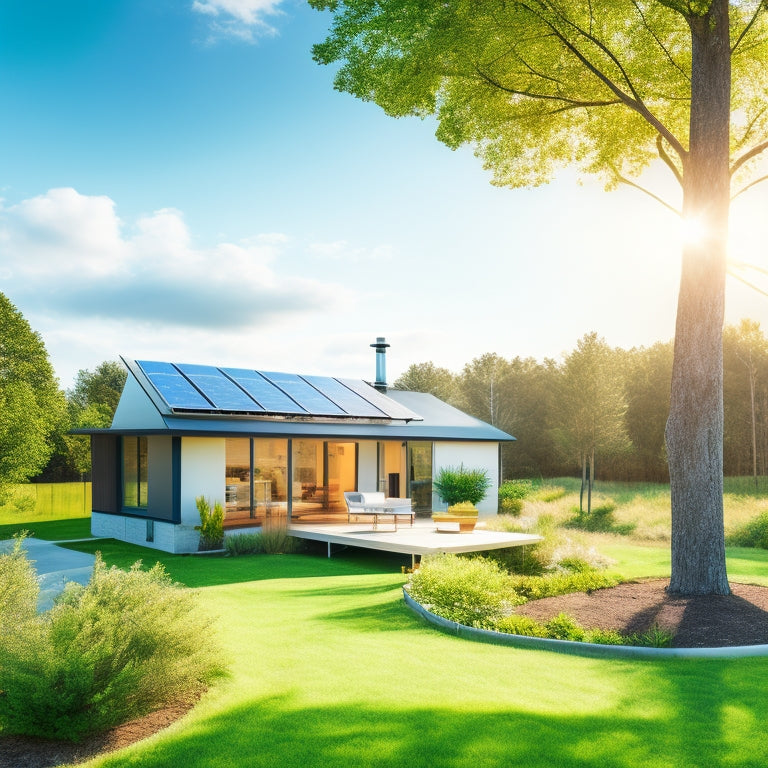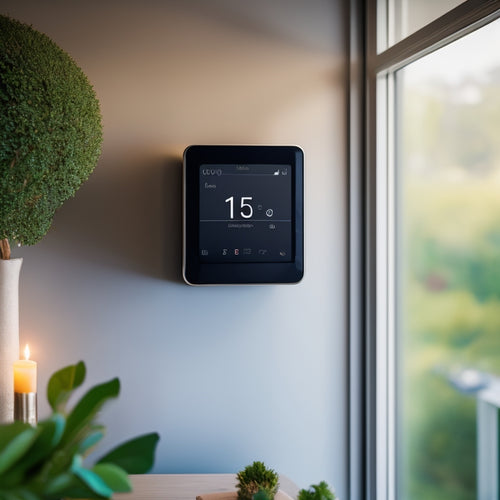
Harness Sun and Wind: Home Energy Revolution Unveiled
Share
By utilizing the power of sun and wind, you can revolutionize your home energy and reduce your reliance on the grid by up to 70%. Hybrid renewable energy systems, combining wind turbines and solar panels, offer a sustainable solution for energy independence and minimizing environmental impact. With strategic planning and installation, you can maximize energy output, reduce your carbon footprint, and save on energy costs. Taking it a step further, advanced energy management systems and smart technology integration can optimize your energy usage, and future-proofing your system can guarantee compliance with emerging trends and regulations - and that's just the beginning of your expedition towards a self-sufficient home.
Key Takeaways
- Hybrid renewable energy systems combining wind turbines and solar panels can reduce grid reliance by up to 70% and ensure energy independence.
- High-efficiency solar panels can achieve conversion rates up to 23%, while strategic component placement increases energy efficiency and reduces losses.
- Cost-effective sustainable solutions, such as insulation and LED lighting, can save up to 30% on energy costs and lower environmental impact.
- Advanced energy management systems enable real-time energy monitoring, data-driven decisions, and optimization of energy efficiency.
- Seamless energy storage integration with hybrid solutions optimizes efficiency and cost, providing reliable power and stabilizing the grid.
Wind Turbine and Solar Panel Combo
With renewable energy gaining traction, you're likely to find yourself at the forefront of the home energy revolution, and a wind turbine and solar panel combo can be a potent combination to harness nature's power.
When considering a hybrid system, you'll want to assess your site's wind energy potential and solar efficiency. Turbine installation requires careful planning, considering weather factors like wind direction and speed.
Solar power integration can reduce grid reliance by up to 70%, leading to significant cost savings. Additionally, mitigating peak shaving reduces grid strain and demand charges.
Maintenance strategies should also be in place to guarantee peak performance. Connecting your system to the grid will allow you to sell excess energy and achieve energy independence.
Performance monitoring will help you track your progress and make adjustments as needed. A thorough site assessment will help you determine the best placement for your turbine and solar panels, maximizing your energy output.
Maximizing Energy Output Potential
Optimizing your hybrid system's layout is crucial to maximizing energy output potential.
You'll want to verify that your solar panels and wind turbines are positioned to capture the most energy possible. This means considering factors like sunlight exposure, wind direction, and shading.
Additionally, incorporating high-efficiency solar panels with conversion rates up to 23% can greatly increase energy yield, reducing surface area requirements high-efficiency solar panels.
By strategically placing your components, you can increase energy efficiency and reduce energy losses.
This, in turn, will help you achieve grid independence, relying less on external power sources and more on your own renewable energy.
With a well-designed system, you'll be able to generate more power and enjoy the freedom that comes with energy self-sufficiency.
Reducing Carbon Footprint Effectively
You're likely aware that reducing your home's carbon footprint is essential in the fight against climate change.
To achieve this, you'll need to focus on reducing carbon emissions, which can be done by increasing energy efficiency and investing in renewable energy sources like solar power for EV charging. This offers a clean energy source and greatly reduces greenhouse gas emissions.
Carbon Emissions Reduction
The quest for a sustainable future hinges on our ability to reduce carbon emissions, and every household plays an essential role in this effort. You can make a notable impact by adopting sustainable living practices that minimize your carbon footprint.
Implementing energy-efficient appliances, insulation, and smart home systems can greatly reduce your energy consumption. Moreover, incorporating renewable energy sources, such as solar-powered fast charging hubs, can also contribute to a cleaner environment.
Additionally, consider carbon offsetting strategies, such as investing in renewable energy projects or reforestation initiatives, to compensate for your remaining emissions. By taking these steps, you'll not only reduce your environmental impact but also lower your energy bills and contribute to a cleaner, healthier environment.
Renewable Energy Sources
Nearly 80% of the world's energy still comes from fossil fuels, making it clear that a significant shift towards renewable energy sources is essential for reducing carbon footprint effectively. You have several options to choose from, each with its benefits and advantages.
| Renewable Energy Source | Description |
|---|---|
| Geothermal Energy | Capturing heat from the Earth's core for electricity generation |
| Tidal Power | Converting ocean tides into electricity through turbines |
| Biomass Energy | Producing energy from organic matter such as wood, crops, and waste |
Switching to renewable energy sources not only reduces your reliance on fossil fuels but also increases energy efficiency. Additionally, you can investigate hydropower solutions, which involve utilizing the energy of moving water to generate electricity. By incorporating these alternatives into your daily life, you'll be contributing to a cleaner, greener environment.
Cost-Effective Sustainable Solutions
You're likely considering ways to reduce your energy bills while minimizing your environmental impact.
Implementing cost-effective sustainable solutions can help you achieve this goal, and exploring green energy savings is a great place to start.
Green Energy Savings
Your wallet and the planet will thank you when you switch to cost-effective sustainable solutions that employ green energy. By investing in energy-efficient systems, you'll reduce your reliance on fossil fuels and lower your utility bills.
Energy efficiency measures, such as insulation, double-glazed windows, and LED lighting, can save you up to 30% on your energy costs. Additionally, smart home devices can optimize your energy usage, detecting areas of inefficiency and suggesting improvements.
Implementing time-of-use rate strategies can further reduce energy costs by shifting non-essential loads to off-peak hours. With green energy savings, you'll not only reduce your carbon footprint but also enjoy significant utility savings over time.
Renewable Power Options
Solar panels, wind turbines, and hydroelectric systems are becoming increasingly cost-competitive with fossil fuels, making renewable power options an attractive alternative for homeowners.
You can generate electricity on your own property, reducing reliance on the grid and lowering your energy bills.
Consider geothermal heating, which utilizes the natural heat of the earth to warm your home. Biomass energy, derived from organic matter, is another viable option.
By investing in these technologies, you'll not only reduce your carbon footprint but also increase your energy independence.
With the cost of renewable energy systems decreasing, it's an opportune time to investigate these sustainable solutions and take control of your energy needs.
Seamless Energy Storage Integration
Energy storage systems play a critical role in stabilizing the grid and ensuring a reliable flow of power to your home. With the integration of renewable energy sources, energy storage solutions become essential to manage excess energy and provide backup power during outages. You'll want to evaluate hybrid solutions that combine different battery technologies to optimize efficiency and cost.
| Energy Management | Storage Solutions | Benefits |
|---|---|---|
| Load Balancing | Battery Technology | Efficient energy distribution |
| Grid Connection | Hybrid Solutions | Renewable integration and energy independence |
| Efficiency Optimization | Smart Systems | Real-time energy monitoring and control |
| Renewable Integration | Advanced Battery Tech | Increased energy storage capacity |
| Energy Independence | Customized Solutions | Customized to your energy needs |
Minimizing Environmental Impact Factors
The carbon footprint of your home's energy system is a critical consideration in today's eco-conscious world. To minimize environmental impact factors, you'll want to focus on energy efficiency through sustainable materials, eco-friendly appliances, and proper home insulation.
Implementing smart technology can also help optimize energy use and reduce waste. Making lifestyle changes, such as reducing energy consumption during peak hours, can also make a significant difference.
Additionally, incorporating green landscaping and participating in community initiatives can further reduce your carbon footprint.
Future-Proofing Home Energy Systems
Upgrading your home's energy system to accommodate emerging technologies and shifting energy environments is crucial in today's fast-paced world.
You'll want to guarantee your system can seamlessly integrate with smart home technologies, allowing for real-time monitoring and optimization.
Implementing advanced energy management systems will enable you to track energy usage, identify areas for improvement, and make data-driven decisions.
This forward-thinking approach will future-proof your home, allowing you to adapt to changing energy environments and regulations.
Frequently Asked Questions
How Do I Determine the Best Turbine Size for My Home's Energy Needs?
To determine the best turbine size, you'll need to assess your energy consumption patterns, then match them to a turbine's capacity, ensuring it can meet your needs while considering factors like wind speed and efficiency.
Can I Install Solar Panels on a Metal or Asphalt Roof?
You'll need to assess roof compatibility before installing solar panels on a metal or asphalt roof, considering factors like weight, structural integrity, and installation angles to guarantee a secure and efficient setup.
Are There Government Incentives for Home Energy System Installations?
You'll be eligible for federal tax credits and state rebates when installing energy-efficient, renewable energy systems, such as solar panels, which can notably offset your investment, giving you more freedom over your energy costs.
How Often Do Wind Turbines and Solar Panels Need Maintenance Checks?
Like a well-oiled machine, your wind turbine and solar panels require regular tune-ups to optimize performance. You'll need to schedule turbine maintenance every 5-10 years and solar upkeep every 6-12 months to guarantee maximum energy harvesting and system longevity.
Can I Use a Single Inverter for Both Wind and Solar Energy Systems?
You'll need to guarantee inverter compatibility for simultaneous energy conversion from both wind and solar sources, so it's essential to choose an inverter specifically designed for hybrid systems, allowing you to efficiently utilize and convert both energies.
Related Posts
-

Smart Energy: Greener Homes With Connected Power Devices
You can control and optimize your energy consumption with smart energy devices, reducing your carbon footprint by up ...
-

7 Blockchain Tools for Home Energy Management
You can utilize blockchain technology to optimize your home's energy management through innovative solutions like blo...
-

10 Best Energy-Efficient External Hard Drives for Sustainable Offices
When it comes to sustainable offices, you need external hard drives that balance data storage needs with energy effic...


